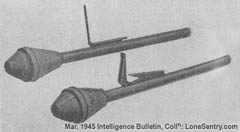Articles >>
Faustpatrone
Category: Term of the day

The Faustpatrone (literally 'fist cartridge') was a German anti-tank weapon of early World War II and a forerunner of the later Panzerfaust. Much smaller in physical appearance, the Faustpatrone was actually heavier than the better known Panzerfaust. Development of the Faustpatrone started in the summer of 1942 at the German company HASAG with the development of the smaller forerunner-prototype called "Gretchen" ("Little Gretel") by a team headed by Dr. Heinrich Langweiler in Leipzig. The basic concept was that of a recoilless gun; neither the Faustpatrone nor its successor the Panzerfaust were rockets.
The following first weapon model of the Panzerfaust-family, the so-called Faustpatrone klein, 30m ("Small Fist-Cartridge") had a total weight of 3.2 kg (7.1 lb) and a total length of 98.5 cm (38¾ in); its projectile had a length of 36 cm (14¼ in) and a warhead diameter of 10 cm (4 in); it carried a shaped charge of 400 g (14 oz) of a 50:50 mix of TNT and tri-hexogen. The propellant consisted of 54 g (1.9 oz or 830 grains) of black powder, the metal launch tube had a length of 80 cm (31½ in) and a diameter of 3.3 cm (1.3 in) (early models reportedly 2.8 cm (1.1 in)). Fitted to the warhead was a wooden shaft with folded stabilizing fins (made of 0.25 mm (0.01 in) thick spring metal). These bent blades straightened into position by themselves as soon as they left the launch tube. The warhead was accelerated to a speed of 28 m/s (92 ft/s), had a range of about 30 m (100 ft) and an armor penetration of up to 140 mm (5½ in) of plain steel. Soon a crude aiming device similar to the one used by the Panzerfaust was added to the design; it was fixed at a range of 30 m (100 ft).
Other designations of this weapon were Faustpatrone 1 or Panzerfaust 30 klein; however, it was common to refer to this weapon simply as the Faustpatrone. Twenty thousand were ordered and the first 500 Faustpatronen were delivered by the manufacturer, HASAG Hugo Schneider AG, Werk Schlieben, in August 1943. Two main problems had already surfaced much earlier in the weapon's trials. First, the original model did not have a sighting device. Second, due to the odd shape of the warhead (see pictures) it tended to ricochet off or explode with less effect on sloped armor, especially on the Russian T-34. Since these problems surfaced already early in testing, the development and production of its successor, the Panzerfaust 30, had already begun by the time of the first deliveries. Still, the small and simple Faustpatrone klein was kept in production well into 1945. |
Dynamit Nobel Defence presents new solutions and concepts at press day
21.07.2009
Anti-tank Rifle
24.01.2009
Discuss
